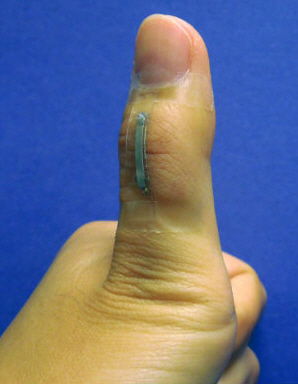It's true - silver nanowires may indeed be more valuable than gold when it comes to developing low cost wearable technology and embeddable sensors for healthcare-focused applications. Developing sensor technology utilizing silver nanowires will soon enable capabilities such as allowing humans to manipulate prosthetic devices or giving robots a real sense of touch. In thinking robots don't leave out the possibility that a prosthetic device may indeed manifest itself as a robotic device, and if that robot should happen to be able to truly "touch" it can in turn be passed on as real world information to the human using the device.
How do we get there? By combining two sets of technologies that have been developed at North Carolina State University. These technologies in turn have allowed researchers to develop wearable and embeddable multifunction sensors that can be used in applications across biomedical, military and athletic applications. These capabilities are all also easily extended to use with next generation prosthetics, various robotic systems and also flexible touch panels.
These devices will all have one thing in common - silver nanowires that have allowed the researchers working on the challenge to develop sensors that are able to highly and effectively measure strain, pressure, human touch and bioelectronic signals such as electrocardiograms in a variety of environments that were formerly not friendly environments for doing so.
Shanshan Yao, a Ph.D. student at North Carolina State University, is the lead author on a just released paper on the work, Wearable Multifunctional Sensors Using Printed Stretchable Conductors Made of Silver Nanowires. He says that, “The technology is based on either physical deformation or 'fringing' electric field changes. The latter is very similar to the mechanism used in smartphone touch screens, but the sensors we’ve developed are stretchable and can be mounted on a variety of curvilinear surfaces such as human skin.”
The most critical word in the above statement is "stretchable" - a key and necessary physical property, and the invention of which was a necessary component to subsequently developing the sensors that are now possible. That invention was driven by Dr. Yong Zhu, an associate professor of mechanical and aerospace engineering at North Carolina State. Dr. Zhu is the senior author of the paper noted above.
The researchers built on Zhu’s earlier work to create highly conductive and elastic conductors that rely on the silver nanowires. The researchers sandwiched an insulating material between two of the stretchable conductors. The two layers then have the ability to store electric charges (if you remember your basic electronics this is called capacitance - which what capacitors do within electronic circuits). Pushing, pulling or touching these newly stretchable conductors changes the capacitance. The sensors themselves, in turn, work by measuring that change in capacitance.
Dr. Zhu noted that, “These sensors could be used to help develop prosthetics that respond to a user’s movement and provide feedback when in use. They could also be used to create robotics that can ‘feel’ their environment, or the sensors could be incorporated into clothing to track motion or monitor an individual’s physical health.”
As an example, the research team put these sensors to use by using them to measure and monitor thumb movement - which would be quite useful in controlling robotic or prosthetic devices. The team has also shown an application that monitors knee movements while a user is in the process of running, walking and jumping.
 The research team further created an array of sensors that can map pressure distribution, which is important for use in robotics and prosthetics applications. The sensors exhibit a fast response time of 40 milliseconds, which equates to being able to measure and monitor strain and pressure in real time. Real time capability is critical to real world use.
The research team further created an array of sensors that can map pressure distribution, which is important for use in robotics and prosthetics applications. The sensors exhibit a fast response time of 40 milliseconds, which equates to being able to measure and monitor strain and pressure in real time. Real time capability is critical to real world use.
Why is the ability to stretch so important? Dr. Zhu claims that, “The deformation involved in the types of movements we seek to measure is large, and would break most other currently available sensor devices. But our sensors can be stretched to 150 percent or more of their original length without losing functionality, so they can handle it.”
Finally, there is one other thing that will no doubt be loved by businesses that will soon enough take the research work out of the labs and put it to use in real products. Cost. Yao underscores this in pointing out that, "Creating these sensors is simple and low cost." High levels of functionality combined with low cost - the necessary formula to getting products out the door and into real use quickly.
We look forward to seeing next generation technology introduced that will fulfill the obvious promise here.
The work noted here has been supported by the National Science Foundation through North Carolina State's’s ASSIST Engineering Research Center. For those who are interested, the full paper we noted above is available for sale and download courtesy of the journal Nanoscale.
Edited by
Cassandra Tucker